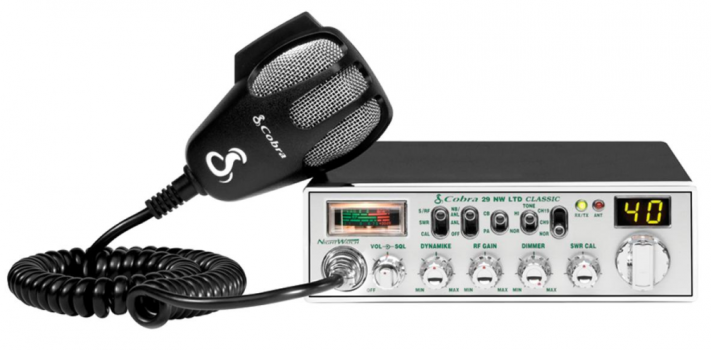Useful Transceivers for Most Preppers
by Tunnel Rabbit, Survival Blog:

The goal of this article to provide readers, the average preppers radio operator, with useful choices that may be capable of meeting a required level of performance. These are some inexpensive, or low power radio options that do not require an Amateur Radio License in the U.S..
Antenna choice is a very important to the part of providing reliable communications within a 10 to 20 mile radius using low powered radios. Terrain also plays an important role. If one located 50 feet higher than the average elevation of the surrounding terrain, the distance it may transmit and receive is much greater. The old rule of thumb in the Amateur Radio world is that ‘height is might’. Even though there will be additional loss of signal in a lengthy run of cable to an antenna that is mounted as high as possible, the additional height of the antenna that avoids obstacles and terrain in the radio wave’s path, easily compensates. In this example, extreme signal loss in a RG-58 cable intended for short runs only, can lose, say half of the signal strength, or 1.5 Dbd, is acceptable if the otherwise low in height antenna installation cannot make reliable communications possible.
Another configuration to consider is that a radio with only 2 watts output, using antenna that mounted at least 15 feet high, and transmits through an antenna with a gain of 1.5 Ddb, can outperform a 10 watt radio transmission that transmits through a 1/4 wave unity gain (no gain) antenna mounted on a vehicle roof. The radio’s frequency also plays an important role in how in negotiates terrain, and obstacles. Radio line of sight in not a straight line. Radio wave can penetrate, or follow the ground, and go around or deflect over hills by about 5 percent, and travel to it’s destination that cannot be seen with the eyes. The longer wave lengths tend to do this much better than the short wave lengths such are used in GMRS radios. GMRS radio using the 3 times shorter in wave length UHF frequencies as compared to VHF frequencies. So they will tend to penetrate some buildings and obstacles much better than VHF. CB radio waves are in the 11 meter band right next to the 10 meter Amateur band. CB transmissions can follow the ground much better than high VHF frequencies that is used in the Multi User Radio Service (MURS) that starts at 151.820MHz.
Three radios and antenna options to consider.
OPTION 1: SSB CB RADIO
Pros:
– No license required.
– Affordable.
– Familiar format.
– No programming needed.
– Can talk with common CB radios.
– Semi-secure. Of the three choices, it provides the highest level of COMSEC.
It is semi-secure, as there a few SSB CBs in use, and standard CBs cannot receive an intelligible signal from SSB CB, when SSB mode is selected.
– Higher effective signal strength due the type of modulation as compared to standard CB radio.
The radio’s rated output is 4 watts, yet when used in Singe Side Band mode, this type modulation has an effective rating of about 12 watts. 12 watts that can provide reliable communications out to at least 10 miles, or more in average terrain. However, both radios in the network need to be CBs with SSB capability.
Cons:
– Large in 20 foot in diameter area needed for the ground plane of the antenna.
OPTION 2: HIGH POWER GMRS MOBILE, OR 8 WATT BAOFENG RADIO
Another option is GMRS radio. Get a ‘no test’ license that covers extended family, and use two 50 watt mobile GMRS radios in the circuit, and mount the antenna on the roof. 25 watts may be needed to cover that distance reliably with a repeater.
Pros:
– Easier installation as the antenna is no more than 12 inches in length.
– No programming required.
– Major cities often have GMRS repeaters, or a licensed user can install their own GMRS repeater.
Cons:
– License required
– This is the least secure radio.
– Higher coaxial cable cost. Expensive low loss coaxial cable that should be the equivalent of 8X or LMR400 is needed to preserve, and carry the full signal strength to the externally roof mounted antenna if maximum range is necessary. Use of an inexpensive high gain Slim Jim, or other design high gain antenna can also be used to offset the considerable loss of signal if inadequately rated, and ‘lossy’ cables are use. This why a 50 watt GMRS radio might be needed to offset the use of lower quality and ‘lossy’ cables, and connectors due to it the nature of UHF frequencies.
OPTION 3, THE COMBINATION OF A 8 WATT HAND HELD RADIO, AND A HIGH GAIN SLIM JIM ANTENNA
Use a 8 watt Baofeng with Slim Jim antenna mounted at least 20 feet above ground level. This antenna can be purchased pre-tuned for MURS frequencies. Use one of the five license-free MURS channels. Odds are this will be adequate, if both the receiving and transmitting station use a Slim Jim antenna. A Slim Jim is a high gain folded 5/8 dipole, with a gain of at least 1.5 Db. Use RG8x or heavier cable and ERP, or power out at the antenna will be at least if not more, 10 watts after a lengthy cable run. 10 watts on high band VHF can easily go a distance of 10 miles with an externally antenna mounted on a roof top. I can hit repeaters 80 miles away with this set up, even Cranbrook, Canada with a such an antenna, and a 4-watt, instead of an 8-watt Baofeng. The supply of Baofengs may however dry up given both regulatory changes and the disruption caused by 2019-nCov (Covid-19).
I much prefer the Slim Jim over the J-pole, as a 4:1 air choke is not required, and it has 8 to 10 Mhz of bandwidth, as compared to the 4 Mhz bandwidth of the J-pole. It probably has higher gain close to 3 Dbd, but it must be mounted at least 20 feet up to use the potentially higher gain out of it, as compared to the J-pole (1.5 Dbd). The Slim Jim sends concentrates the signal in 20 degree pattern, and sends towards the horizon. I would not use a J-pole unless the SWR (Standing Wave Ratio) could be confirmed and the user can create an 4:1 air choke. Otherwise the SWR exceeds 2:1 with J-poles without such an air choke.
Meet it’s maker, KB9VBR. Excellent customer service with prices I cannot beat. Yet I’ve made piles of these, and can do fine tuning to take advantage of it’s considerable and advantageous bandwidth. The J- poles do have their place though.
Pros:
– Least expensive option
– No license required
– Common Prepper frequency
– Dual purpose as the radio can act as a slow scanner of Emergency Services to GMRS/FRS radio traffic, and Ham Bands.
– More secure than GMRS
– The Baofeng or other hand held can be used as a scanner to monitor the Ham bands, Emergency Services, VHF Land Mobile, and GMRS/FRS.
Cons:
– Relatively easy programming of at least one frequency, using the VFO (Variable Frequency Oscillator) mode required.
– Additional programming to access the full potential of the radio can be problematic without the use of Chirp software, and a programming cable with the proper chip set.
– Less secure than SSB CB.
– License free channels limited to the 5 MURS frequencies as compared to the 80 upper and lower side band frequencies of the SSB CB.
IMPROVING RANGE AND (COMMUNICATIONS SECURITY (COMSEC) WITH A 3 OR 5 ELEMENT YAGIS.
Using low power radios is already a good start to making communications secure. Low power is your friend. Always use the lowest power setting the radio offers to reduce the potential of being overheard. However, we may also wish to extend the range further that the low power hand held or CB radio is capable of. To retain the security benefits of low power, and still make contacts with stations that would normally require the higher power levels available in mobile/base station radios, we can use a high gain directional antenna. Directional antennas are made for all frequencies, yet the lower the frequency, the larger that a directional antenna must be. A yagi not only magnifies the power out, it also hears the weak signals of lower powered radios better, greatly extending the range of the lowered power station should it be talking to the station using a yagi. The smaller 3 element yagi transmits and receives in a footprint of about 45 degrees, and block signals coming from behind and from the sides of the antennas elements providing low noise floor. Yagi antennas are ideal for point-to-point communications, and are almost impossible to direction find (DF), and can be permanently mounted just like many other antennas.
A DIRECTIONAL 3 ELEMENT YAGI ANTENNA FOR CB, OR SSB CB.
In the case of the SSB CB, a 10 meter yagi can be adapted, and tuned to CB frequencies. This however requires some prior experience. It is better to buy, or special order a yagi specifically made for CB frequencies. A horizontally polarized yagi transmitting on upper and low side band in CB frequencies at 12, or less watts is far off the beaten path, and could be considered the most secure that the average prepper might obtain. it is more secure that using any of the Ham bands. Even scanners would not receive side band intelligently, and the receiving station would likely interpret the garbled voices as ‘skip’. Use a SSB CB on a 3 element yagi with a gain of 7.5 Dbd, and the ERP (estimated radiated power) can be around 67 watts, if line loss is not deducted. If the standard CB portion of the radio is used, and transmits on 4 watt, the ERP would be 22 watts. This means the range in a roughly 45 degree foot print is greatly extended to at least 20 miles.
To improve COMSEC (Communication Security), without using an inconveniently large and expensive yagi, make your own dipole antenna, and mount it horizontally to significantly increase the odds that your communications are secure. Both receiving and transmitting antennas must be mount in the same way. This is inexpensive to do, but does require and a SWR meter, 20 feet or more feet of coaxial cable with a PL259 cable end, or 18 feet of wire, and a some time. This a bi-directional antenna. The broadside of the antenna should be perpendicular to the intended receiving station. This is a 72 ohm antenna connected to a 50 ohm system, yet the impedance mismatch is negligible given the considerable advantages of this type of antenna when used in a horizontally polarized configuration. They tune up with a low SWR and broad bandwidth.
A DIRECTIONAL 3 ELEMENT YAGI ANTENNA FOR GMRS MOBILE RADIOS.
I am not certain of the legalities, yet a in austere environment, a mobile 50 watt GMRS radio could obtain similar benefits that such an antenna provides any radio. The advantage of a yagi designed for GMRS frequencies is small and portable size, about 20 inches square. Here we can power down the output to 10 watts, conserve battery power, and reach longer ranges, as previously discussed. Using 50 watts, the ERP would be an excessive 281 watts. More sensible choice would be a mere 10 watts, putting the ERP at about 57 watts. Here we can also use a 8 watt Baofeng, that will actually transmit close to 10 watts on UHF frequencies that includes GMRS. In my experience in wooded areas, it is best to double the ERP when using UHF frequencies to effect the same range as a VHF radio would have. All the security benefits apply here, except GMRS is not SSB, and is a commonly used set of frequencies, and more likely to be intercepted. Fortunately using a yagi would reduce the potential audience size by 75%.
Loading...



